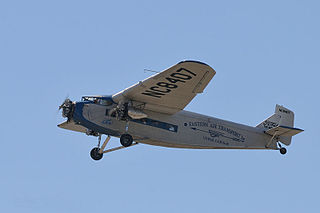
The Ford Trimotor is an American three-engined transport aircraft. Production started in 1925 by the companies of Henry Ford and ended on June 7, 1933, after 199 had been made. It was designed for the civil aviation market, but also saw service with military units.
This is a list of aviation-related events from 1934:
This is a list of aviation-related events from 1930:
This is a list of aviation-related events from 1929:

Varney Air Lines was an American airline company that started service on April 6, 1926, as an airmail carrier. Formed by Walter Varney, the airline was based in Boise, Idaho, United States. The airline is one of the predecessors of United Airlines.

The Ford Reliability Tour, properly called "The National Air Tour for the Edsel B. Ford Reliability Trophy", was a series of aerial tours sponsored in part by Ford from 1925 to 1931 and re-created in 2003. Top prize was the Edsel Ford Reliability Trophy. Henry and Edsel Ford were shareholders in the Stout Engineering Company. In August 1925, they purchased the entire company, making it the Stout Metal Airplane Division of the Ford Motor Company. Their product, the Stout 2-AT Pullman, was a featured plane. The plane was also used by their new airline the Ford Air Transport Service, which started regular flights in April. The flights out of Ford Airport (Dearborn) cross-marketed, and showcased Ford's new interest in aviation.
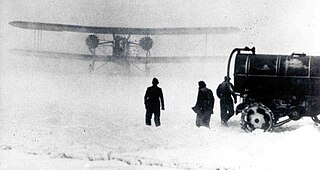
The Air Mail scandal, also known as the Air Mail fiasco, is the name that the American press gave to the political scandal resulting from a 1934 congressional investigation of the awarding of contracts to certain airlines to carry airmail and the subsequent disastrous use of the U.S. Army Air Corps to fly the mail after the contracts were revoked.

William Bushnell Stout was a pioneering American inventor, engineer, developer and designer whose works in the automotive and aviation fields were groundbreaking. Known by the nickname "Bill", Stout designed an aircraft that eventually became the Ford Trimotor and was an executive at the Ford Motor Company.
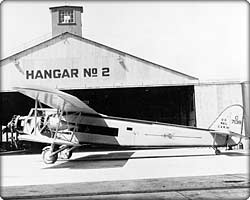
The Boeing 80 was an American airliner of the 1920s. A three-engined biplane, the Model 80 was built by the Boeing Airplane Company for Boeing's own airline, Boeing Air Transport, successfully carrying both airmail and passengers on scheduled services.
Ford Airport in Dearborn, Michigan, United States, was one of the first modern airports in the world. It operated from 1924 to 1947. The site is now part of Ford Motor Company's Dearborn Proving Ground. The airport was about 360 acres (150 ha) in size.
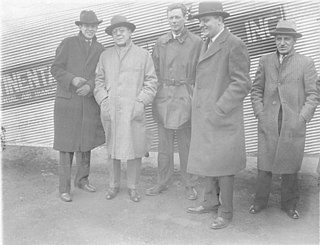
Transcontinental Air Transport (T-A-T) was an airline founded in 1928 by Clement Melville Keys that merged in 1930 with Western Air Express to form what became TWA. Keys enlisted the help of Charles Lindbergh to design a transcontinental network to get government airmail contracts. Lindbergh established numerous airports across the country in this effort.
Pacific Air Transport was an early US airline, formed in 1926 for carrying mail as well as passengers. It was acquired two years later by Boeing Air Transport.

United States airmail was a service class of the United States Post Office Department (USPOD) and its successor United States Postal Service (USPS) delivering air mail by aircraft flown within the United States and its possessions and territories. Letters and parcels intended for air mail service were marked as "Via Air Mail", appropriately franked, and assigned to any then existing class or sub-class of the Air Mail service.
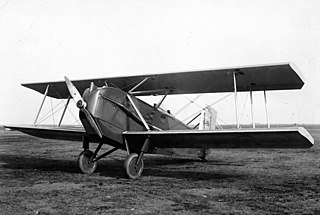
The Curtiss Carrier Pigeon was an American mail plane of the 1920s. A single-engined biplane designed and built to replace World War I surplus aircraft such as the DH-4, the Carrier Pigeon was one of the first aircraft designed specifically for U.S. Airmail service.

Stout Metal Airplane Division of the Ford Motor Company was an American aircraft manufacturer founded by William Bushnell Stout as the Stout Metal Airplane Co. in 1922. The company was purchased by Ford Motor Company in 1924 and later produced the Ford Trimotor. At the height of the Great Depression, Ford closed the aircraft design and production division in 1936, temporarily re-entering the aviation market with the production of the B-24, at the Willow Run aircraft factory during World War II.

The Stout 2-AT Pullman, or "Air Pullman", was a single engine all-metal monoplane that was used for early airline travel and air mail transport in America.
Ford Air Transport Service is a defunct airline based in United States of America. The airline was also registered as Ford Air Freight Lines.
Stout Air Services was an airline based in the United States. Stout Air Services was the first regularly scheduled passenger airline in America.

The Curtiss Model 41 Lark was a commercial biplane manufactured by Curtiss Aeroplane and Motor Company that was used by pioneering airmail, airline and bush pilots in the 1920s.

Lewis Summers Turner was a clerk, automobile salesman, Army pilot, barnstormer, airmail pilot, airline pilot, and one of ten recipients of the Airmail Flyers' Medal of Honor.












